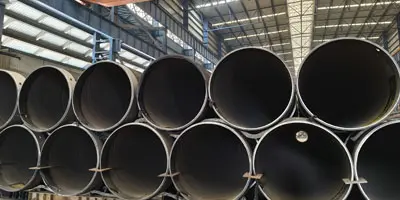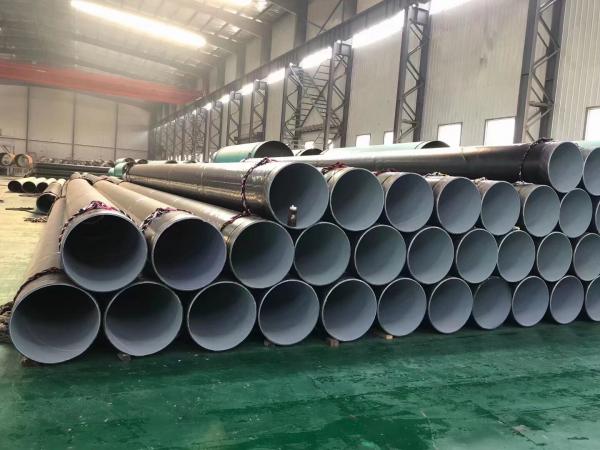Definition of steel pipes
Steel pipes are hollow long strips of steel, which are widely used as pipelines for conveying fluids, such as oil, natural gas, water, coal gas, steam, etc. In addition, when bending and torsional strength are the same, the weight is light, so it is also widely used in the manufacture of mechanical parts and engineering structures. It is also commonly used to produce various conventional weapons, gun barrels, shells, etc.
Classification of steel pipes
Classification of steel pipes: Steel pipes are divided into two categories: seamless steel pipes and welded steel pipes (seam pipes). According to the cross-sectional shape, they can be divided into round pipes and special-shaped pipes. Round steel pipes are widely used, but there are also some square, rectangular, semicircular, hexagonal, equilateral triangle, octagonal and other special-shaped steel pipes. For steel pipes that bear fluid pressure, hydraulic tests must be carried out to test their pressure resistance and quality. They are qualified if there is no leakage, soaking or expansion under the specified pressure. Some steel pipes must also undergo curling tests, expansion tests, flattening tests, etc. according to standards or requirements of the purchaser.
1.
Welded steel pipe: also called
welded pipe, it is made of steel plate or steel strip after bending and then welding. According to the form of weld seam, it is divided into straight seam welded pipe and spiral welded pipe. Classification of welded steel pipes by use: according to use, it is divided into general welded steel pipe, galvanized welded steel pipe, oxygen-blown welded steel pipe, wire casing, metric welded steel pipe, roller pipe, deep well pump pipe, automobile pipe, transformer pipe, electric welded thin-walled pipe, electric welded special-shaped pipe and spiral welded steel pipe.
2. Seamless steel pipe for low and medium pressure boilers: used to manufacture various low and medium pressure boilers, superheated steam pipes, boiling water pipes, water-cooled wall pipes and locomotive boilers. Superheated steam pipes, large smoke pipes, small smoke pipes and arch brick pipes. Use high-quality carbon structural steel hot-rolled or cold-rolled (drawn) seamless steel pipes. Mainly made of 10.20 steel, in addition to ensuring chemical composition and mechanical properties, water pressure tests, curling, flaring, flattening and other tests must be performed. Hot rolling is delivered in hot rolling state. Cold rolling (drawing) is delivered in heat treatment state.
3. High-pressure boiler steel pipe: mainly used to manufacture high-quality carbon structural steel, alloy structural steel and stainless heat-resistant steel seamless steel pipes for steam boiler pipes with high pressure and above. These boiler pipes are working under high temperature and high pressure. The pipes will also oxidize and corrode under the action of high-temperature flue gas and water vapor. Therefore, the steel pipes are required to have high lasting strength, high oxidation resistance, and good organizational stability. The steel grades used are: high-quality carbon structural steel grades are 20G., 20MnG., 25MnG;
4. Alloy structural steel: 15MoG., 20MoG., 12CrMoG., 15CrMoG, 12Cr2MoG, 12CrMoVG., 12Cr3MoVSiTiB, etc.;
5.
Seamless steel pipes for oil drilling are the main equipment for drilling, mainly including core outer pipe, core inner pipe, casing, drill pipe, etc. Since the drilling pipes have to work at a depth of several thousand meters, the working conditions are extremely complex. The drill pipes are subjected to stresses such as tension, compression, bending, torsion and unbalanced impact loads, and are also subject to mud and rock wear. Therefore, the pipes must have sufficient strength, hardness, wear resistance and impact toughness.
6. Oil cracking pipes: seamless pipes used for furnace tubes, heat exchanger tubes and pipelines in oil refineries. Commonly used high-quality carbon steel (10.20), alloy steel (12CrMo.15CrMo), heat-resistant steel (12Cr2Mo.15Cr5Mo), stainless steel (1Cr18Ni9.1Cr18Ni9Ti) manufacturing.
7. Stainless steel pipes: stainless steel pipes made of various hot-rolled and cold-rolled stainless steel pipes are widely used in petroleum and chemical equipment pipelines and stainless steel structural parts for various purposes. In addition to ensuring the chemical composition and mechanical properties, all steel pipes used to withstand fluid pressure must ensure that the water pressure test is qualified. Various special steel pipes must be guaranteed according to regulations.
8.
Black Steel Pipe (Uncoated): This is the most common type and is used for general construction and low-pressure applications. It is susceptible to rust and requires paint or coating for protection in exposed environments.
Steel Pipe Specifications
Steel pipe is classified according to different specifications to determine its suitability for different uses:
Size: Defined by the nominal diameter (ND) or nominal pipe size (NPS), ranging from small diameter (1/8 inch) to large diameter (60 inches). The diameter determines the flow rate.
Dimensions: Includes outside diameter (OD), inside diameter (ID), and wall thickness.
Weight: Determined by pipe size and wall thickness, usually in pounds per foot or kilograms per meter. It helps determine shipping costs and structural load considerations.
Specification: Indicates the wall thickness relative to the diameter, common specifications include SCH 40, SCH 80, and SCH 160. The higher the specification, the thicker the wall thickness and the higher the pressure capacity.
How is Steel Pipe Made?
The manufacturing process of steel pipe involves several steps, each of which is critical to ensure the pipe's strength, durability, and compliance with industry standards:
Raw material selection: High-quality steel is selected based on the pipe's intended use. Melting and casting: The steel is melted in a furnace and cast into billets or slabs.
Forming: The billet or slab is then heated and rolled into a cylindrical shape.
Electrical resistance welding (ERW): This is the most common method. The coiled steel sheet is formed into a cylindrical shape and its edges are heated with a high-frequency electric current. The molten metal fuses together to form a strong weld.
Seamless pipe manufacturing: For seamless pipe, the billet is perforated to form a hollow tube, which is then rolled and stretched to the desired size. This method produces pipes with higher strength and is generally used for high-pressure applications.
Sizing and shaping: The pipe is sized and shaped to specifications through a series of rollers.
Heat treatment: The pipe is heat treated to improve its mechanical properties.
Inspection and testing: The pipe is inspected for defects and tested for strength, durability, and compliance with standards.






 English
English Español
Español بالعربية
بالعربية











 Phone :
Phone :  Whatsapp :
Whatsapp :  Email :
Email : 


